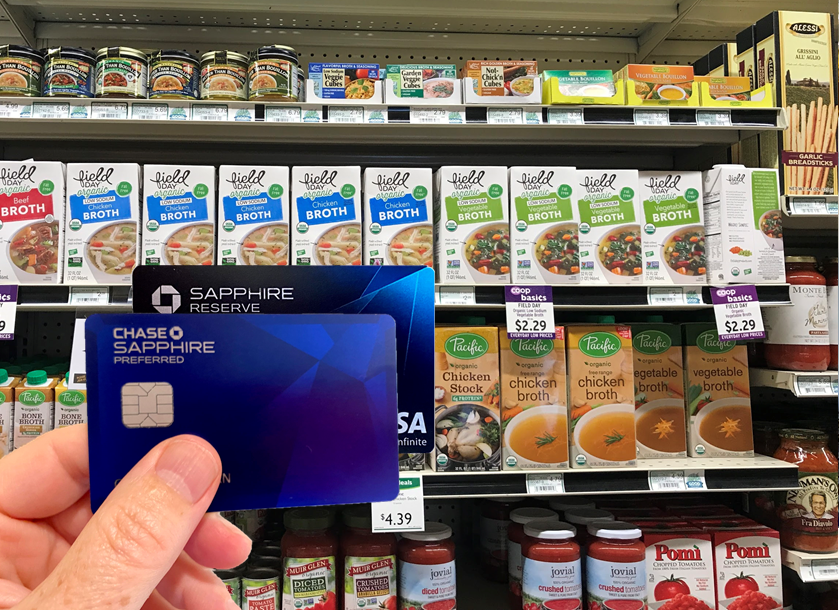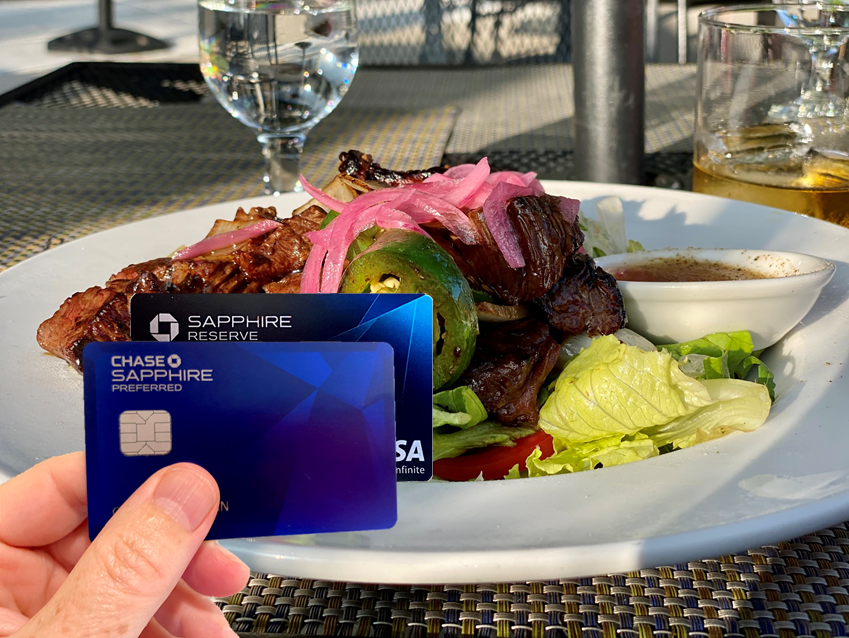
Chase’s “Pay Yourself Back” feature lets Sapphire Preferred and Sapphire Reserve cardholders exchange Ultimate Rewards points for statement credits against certain categories of purchases at full travel value. Sapphire Preferred cardholders get 1.25 cents per point, and Sapphire Reserve cardholders get 1.5 cents per point. Currently you can redeem points to offset grocery, restaurant, food delivery & takeout, home improvement store purchases, and select charitable contributions.
Pay Yourself Back is also available to Freedom and select Ink cardholders, but with those cards the eligible spend categories are severely limited. For the purpose of this post I’ll focus only on the two eligible Sapphire cards. For complete details about Pay Yourself Back, click here.
Earn and redeem at once
Unlike most opportunities to redeem rewards points, with Pay Yourself Back you earn points on the same purchases that you redeem for. For example, suppose you use your Sapphire Preferred card (which earns 2X for travel & dining) to spend $50 at a restaurant. You’ll automatically earn 100 points. You’ll also have the opportunity to reimburse that statement charge (via Pay Yourself Back) with 4,000 points. In this way it works a lot like the Capital One Venture Rewards card which lets you reimburse travel credits from purchases where you earn points (which they confusingly call “miles”).
When you compare this to rewards where you go through a rewards portal to redeem points for travel or merchandise, this is way better. With a rewards portal, you’re limited to the rewards options they have available, you’re limited to the prices they list, and you won’t earn points at the same time. With Chase’s Pay Yourself Back, you can get anything you want at any restaurant, grocery store, or home improvement store; pay the best discounted price; earn rewards on the purchase; and get full value from your points. It’s awesome.
Opportunity Cost
One concern some have is the opportunity cost of using a Sapphire Preferred or Sapphire Reserve card for purchases when another card would offer you better rewards.
For example, suppose you have the fee-free US Bank Altitude Go card which offers 4% cash back for dining. Should you use your Go card at restaurants in order to get 4% or your Sapphire to get 2X rewards (Sapphire Preferred) or 3X rewards (Sapphire Reserve) plus the ability to “Pay Yourself Back”?
One way to think of it is that the Sapphire Preferred earns the equivalent of 2.5% back for travel & dining, and 1.25% everywhere else; and the Sapphire Reserve earns the equivalent of 4.5% back for travel & dining, and 1.5% everywhere else. With those rebates in mind, you can figure out how much of each purchase you’re “losing” by using your Sapphire card. For example, if you use the Sapphire Preferred for dining (2.5% back) instead of your Altitude Go (4%), you’re “losing” 1.5% on this spend. On a hundred dollar dining charge, that amounts to $1.50 “lost”. On the other hand, if you have the Sapphire Reserve, you’re better off paying with that card (4.5% cash equivalent for dining) than the Go card (4% cash back for dining).
A similar question comes up with cards that earn more points. Let’s consider, for example, the Amex Gold card which earns 4X at US Supermarkets (up to $25K per year, then 1X) and 4X at restaurants worldwide. Now compare that to the Sapphire Reserve card which earns 1X at supermarkets and 3X at restaurants. If you use the Sapphire Reserve card at supermarkets instead of your Gold card, you’re effectively giving up 3 points per dollar (1X vs 4X). At restaurants, you’re giving up only 1 point per dollar (3X vs 4X).
I created a chart to show how much less value you get by choosing the Sapphire Preferred or Sapphire Reserve when compared to another card that earns more points. This assumes that the alternate card’s points are worth the same as Chase Ultimate Rewards:
| Alternate Card Points Per Dollar | Sapphire Preferred Cents Per Point Value | Sapphire Reserve Cents Per Point Value |
|---|---|---|
| Same | 1.25 | 1.50 |
| +1 | 1.23 | 1.48 |
| +2 | 1.22 | 1.46 |
| +3 | 1.20 | 1.44 |
| +4 | 1.19 | 1.42 |
Since the Amex gold card earns 3 additional points for grocery purchases when compared to either the Sapphire Preferred or Sapphire Reserve, you would look at the “+3” row to see the cents per point value you would get by using your Sapphire card and then paying yourself back with points. With the Sapphire Preferred card you would get 1.2 cents per point value and with the Sapphire Reserve you would get 1.44 cents per point value. Either way, that’s far more value than most points program offer to cash out points so I’d argue that for most people it’s still worth it (unless you’re keeping your points for more valuable transfer partners)
Maximizing Value (Simple Approach)

If you have a great alternate card for groceries, then use your Sapphire card only for dining. Since both Sapphire cards earn only 1X at grocery stores, this is the place you’re most likely to do better with other cards.
If you have a card that is more rewarding for dining, then once you’ve redeemed all of the points you want to redeem, switch to your more rewarding card for dining. Similarly, if you have a short term promotion on one card that offers better dining rewards, you could simply switch to that other card until the promo is over and then go back to using your Sapphire card.
According to the US Bureau of Labor Statistics, the average US household spends about $3.5K per year eating out. You would need to redeem 280K Sapphire Preferred points or 233K Sapphire Reserve points to Pay Yourself Back for that much spend. My point is that dining spend alone should be more than enough for most households to cash out however many points they want to cash out.
Considerations for Manufactured Spending
Some people earn lots of points through “manufactured spending.” If that’s you, then it may be the case that your regular dining spend isn’t enough to cash out as many points as you would like. In that case, you may want to use your well-honed techniques to increase spend at grocery stores with your Sapphire Reserve card so that you can cash out more points at 1.5 cents each. Caution, please see: Why Chase shutdowns have increased and how to avoid them.
If you do this, you may think that you’re losing out due to the opportunity cost of earning only 1X at grocery stores with your Sapphire Reserve card. And that’s true, but only if this spend is instead of manufactured spend you would have done anyway. For example, if you spend $20K at grocery stores with your Sapphire Reserve and that stops you from your plan to spend $20K on your Amex Gold card, then there’s a true opportunity cost. In this case, use the table I presented above to figure out the true per-point value of Pay Yourself Back. For example, if you use the Sapphire Reserve (1X) instead of the Amex Gold (4X), then you lose out on 3X earnings and your true cash out value is 1.44 cents per point, not 1.5.
If the increased grocery spend you do with the Sapphire Reserve is in addition to other spend (rather than replacing other spend), then there’s no real opportunity cost. In this case, as long as the 1X earnings (1.5% value) are enough to cover your manufactured spending expenses, I think it’s correct to think of the cash out value as being the full 1.5 cents per dollar.





[…] at all and also have a Chase Sapphire Reserve in your household since the points can be used to pay yourself back for $112.50 in purchases at grocery or home improvement […]
[…] points, you could theoretically “cash out” just over 240,000 Ultimate Rewards points via Chase Pay Yourself Back for the ~$3600 you need to pay for the hotel. That is far fewer points than an award stay would […]
[…] via the Chase Sapphire Reserve (either to book travel through the Chase portal or for the awesome Pay Yourself Back feature). That could make the 75K introductory bonus on either of these cards worth as much $1,125 for […]
[…] we previously found that you would still earn points on purchases covered with the Pay Yourself Back feature, this means that you will still be able to earn 3x on a purchase and later use points to pay […]
It may be worth noting the overlap with the $300 travel credit working for gas and groceries this year. One could use the CSR to buy groceries, have the charge offset by the travel credit, redeem UR via PYB to cover the charge a second time, and earn the base 1 UR/$ for the purchase.
Greg
The chart is nice, but how do you get the values there?
I look at it differently
For example let us use a hypothetical scenario of a family with 2 cards
They have 2 cards – Freedom unlimited and Sapphire Reserve for different family members who can NOT transfer back and forth (prior chase shutdowns)
They also have over 200k points – want cash back for, mostly in Sapphire
They also do not travel much any more (have Plenty of Airline points) and the only way one can cash out the points is by cash back
One can book cancelable tickets with awards but the travel expenses for fees are not redeeemable for 1.5c.
One can try booking cancelable tickets on Chase portal (have not done that much) for 2k and then canceling a month or two later and waiting for refunds.
I am not sure if Chase will give money back in account or just credit to Chase portal rewards for ticket cancels
As Long As One Has a Lot of UR points Stashed – Use the Sapphire for spend
One can buy groceries with Sapphire or freedom for 150$ = 150 points = 2$
If you use the 10k points from Sapphire, you get 150$ cash back
If you use the Freedom card to get the 150$ of groceries – get 750 points = worth at most 10$ cash back, plus cash out 10k at 1c each = 110$.
So real rebate is 152$ for 10k points instead of 110$ if used freedom account
42$/10k points = 0.42% better value for points
My question is if is worth keeping the Sapphire card AFTER spending UR stash
If you have points as I do now, it is a great card to redeem.
Once you spend UR then the Freedom is a better card for the present environment 5% cash back is better than 1.5%, even if you can transfer between
If you decide to keep 2 cards (AND can transfer, you get 6% extra with the combo)
5×1.5=7.5 vs 1.5 = 6% better than the Reserve alone
or
7.5 vs 5 = only 2.5% better than Freedom alone
But this assumes cashing out on travel
– if you plan to cash out on groceries, and keep both cards
A typical family spends 500-1000 a month on groceries
Having both cards and spending 1000 a month total among them
So if you spend 500 on Freedom (get 7.5%) and redeem 500 on the Sapphire (get 1.5%) = 6000$ @ 7.5%+1.5% = 540$ value for 150$ cost of Reserve card
Having only Freedom
1000 a month x 12 months = 12000 = 5% cash back = 600$ cash back
you get 60$ more by canceling the Sapphire, not to mention the 150$ fee
I think most calculations have changed after travel rewards no longer an issue
Trying to understand the value of this new feature. Keeping it simple and just dealing with people who want cash back, would I ever put non-bonused spend like grocery or home improvement on this card if I had a Citi Doublecash card? Thanks.
You should put most of your spending on a higher % card and transfer your points to Sapphire Reserve to get 50% more value.
Freedom Unlimited gives you 1.5% back, transfer points to Sapphire for 50% more and you are basically getting 2.25% back.
the chase lineup right now makes Double Cash basically useless.
Light bulb just went off. Now I understand why people think this is a big deal for people who want cash back instead of transferable points.
I was the one who originally asked this question as I posed the conundrum I had with earning groceries at 1.5X UR with my Freedom Unlimited vs. Cash Back with the Reserve, although earning 1.0X on Groceries with that card.
If I understand Greg correctly, the extra .75X UR I would earn thru the transfer to the Sapphire Reserve from the Freedom Unlimited, is less than +1 of the same UR currency, thus, purchasing groceries initially with the Sapphire Reserve and then cashing out, would mean a diminution from 1.5 cents/point to somewhere in between 1.48 to 1.49 cents/point — such a paltry loss I can live with especially since I have over 400,000 UR points.
Moreover, I have over 1 million Hilton; Marriott and United Airlines points and over 400,000 Hyatt points. Therefore, I believe that most have advised that I should earn and cash out on the Sapphire Reserve.
If you think otherwise, however, I certainly am open to your advice!
So, comments yea or any, are most welcome!
Thanks!
Hadley
Buy 8 Visa gift cards at a grocery store, pay yourself back, pull money orders, deposit them in your bank and start over.
travel is gone for at least another year or two, take the money and run.